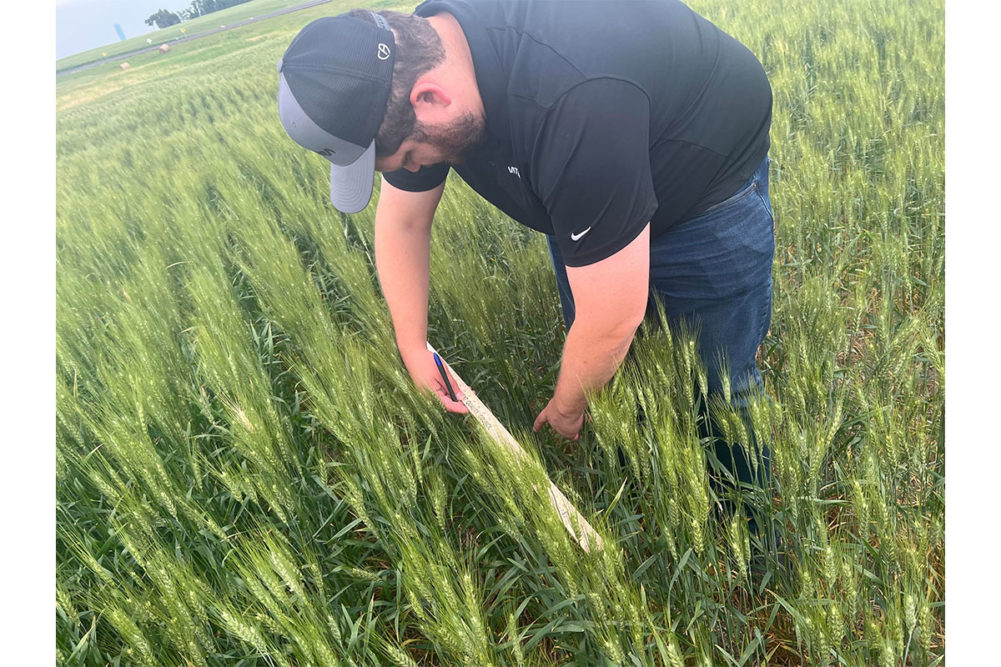MANDAN, ND. — Variability was the key word from wheat scouts who explored spring wheat and durum fields in southeast North Dakota July 25 during Day 1 of the Hard Spring and Durum Wheat Quality Tour. Behind the wide range of 2023 hard red spring wheat yield estimates was the delayed planting period back in May and Mother Nature’s uneven issuance of rain since.
Fifty-seven scouts traveled in 14 rented SUVs and minivans along one of seven circuitous color-coded routes from Fargo to Mandan. The color designations and consistent routes were designed to allow comparisons to previous crop years. One Day 1 route, purple, which dropped straight south from Fargo into northeast South Dakota and proceeded west through five of that state’s counties, was eliminated due to a consistent lack of wheat in rotations there. The remaining routes mostly examined spring wheat and durum in the southeast quadrant of North Dakota.
The green route shimmied east out of Fargo into western Minnesota before jutting west along North Dakota’s southern border. Green route yield estimates were as high as 59.6 bus per acre (bpa), as low as 20 bpa and averaged in the low 40s. Scouts reporting from the route said wheat planted early (around the last week of April) was nearly ready for harvest and of high quality but with disappointing yield potential. Later-planted wheat had more production potential but appeared as many as 40 days out from harvest. Reports from the yellow route — which cut west from Lisbon to Linton, ND, before stairstepping northwest to Bismarck — featured high variability, some signs of drought and heat stress and occasional presence of ergot and grasshopper pressure. Yields ranged from a high of 80.6 bpa to a low of 26.7 bpa and averaged just above 50 bpa.
The orange route, westbound from Kindred to Hazelton, ND, and then north to Bismarck, notched the day’s second highest yield estimate, 88.3 bpa, but estimated other fields in the high-20s. Orange scouts said harvest along the route was one to four weeks out and noted grasshopper presence. Red route reporters said harvest was 14 to 21 days out, calculated an average yield of 46.2 bpa and noted instances of aphid pressure. The pink route launched north to Cooperstown and then zigged and zagged to the north and south enroute to Mandan. Pink presenters outlined a variety of issues found in the wheat, including fusarium head blight (scab), evidence of drought stress and presence of aphids and grasshoppers, but noted no overwhelming prevalence of any of the flaws. Yields ranged from 57.2 bpa to 19.6 bpa and averaged 39. Early planted wheat looked to be ready for harvest in two weeks while later-planted wheat appeared five weeks out.
Two routes, blue and black, strayed out of the southeast into southwest North Dakota. Blue yield estimates ranged widely by field from 21.2 bpa on the low end to 71.3 bpa and averaged 44.9. Black route calculated yield estimates ranged from 117.5 bpa to 40.4 bpa with an average of 66.5.
In total, scouts’ appraisal of 130 hard red spring wheat fields resulted in a tour Day 1 yield estimate of 48.1 bus per acre. That was down slightly from the 2022 Day 1 average yield estimate of 48.9 bpa but topped the 2017-22 Day 1 average of 40.2 bpa. The tour was not conducted in 2020 due to the COVID-19 pandemic.
Three vehicles, one apiece following the pink, blue and black routes, visited a total of five durum wheat fields. All were in excellent shape and the average durum yield was 53.6 bpa, well above the 2022 tour’s Day 1 durum average of 41.4 bpa and the 2017-22 average of 39.3 bpa.
Scouts were set to depart Mandan early July 26 in reconfigured foursomes following various routes to Devils Lake, ND. Blue, green and yellow routes will cover central North Dakota. Red route riders were to measure wheat fields in north-central North Dakota. Pink and orange route riders would stray to the northwest as the tour came closest to the Canadian border.
Tour attendees include producers, grain company employees, elevator operators, millers, bakers and suppliers, along with scouts hailing from academia, government and the media. An agribusiness company representative from Sao Paolo, Brazil, traveled the furthest for the tour, said Dave Green, executive vice president of the Wheat Quality Council and one of the tour’s organizers.
“What we’ve seen here on the first day of the tour is that some of the concerns about the crop may have been overstated,” Mr. Green said. “It’s not a huge crop, but it’s mostly in good shape and there is a lot of high-quality wheat growing in North Dakota.”





